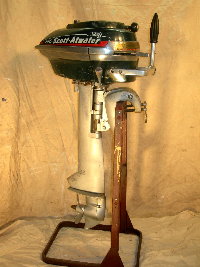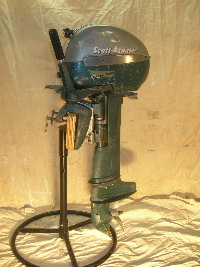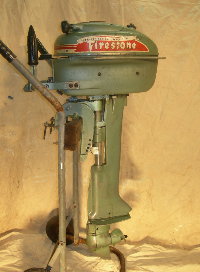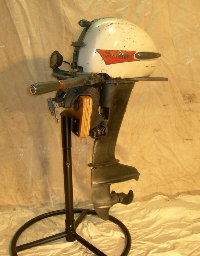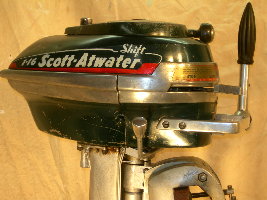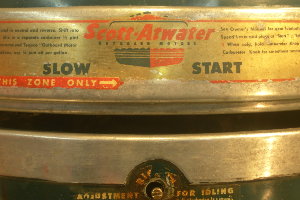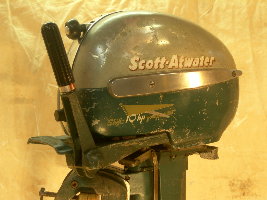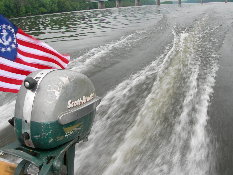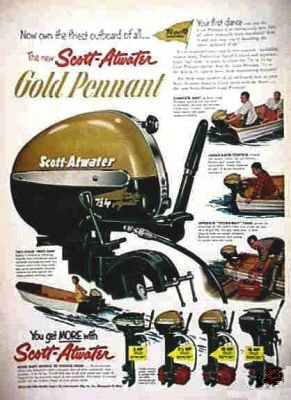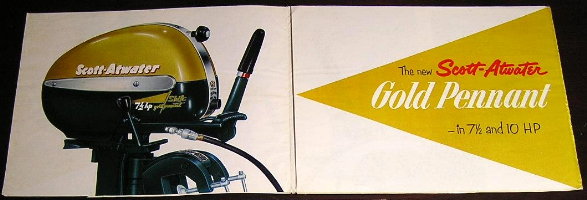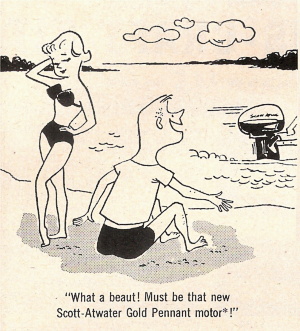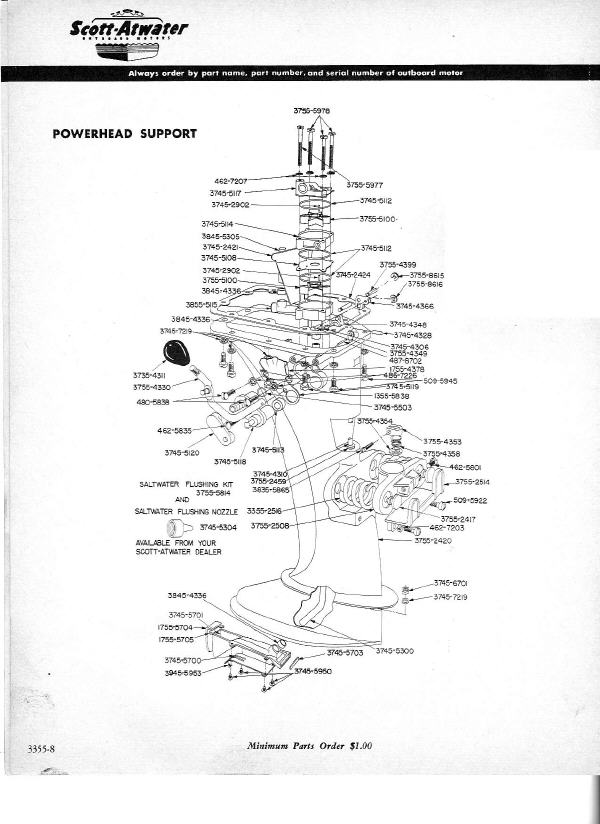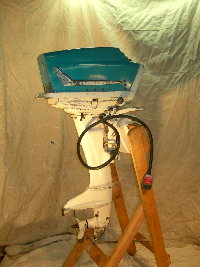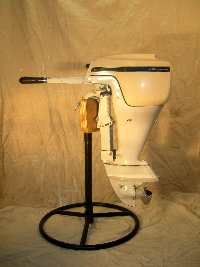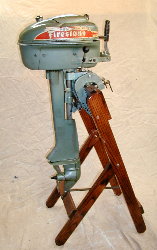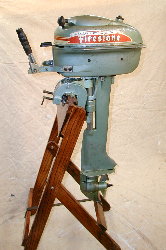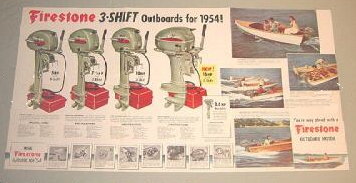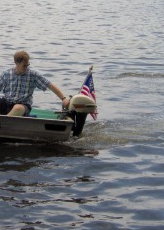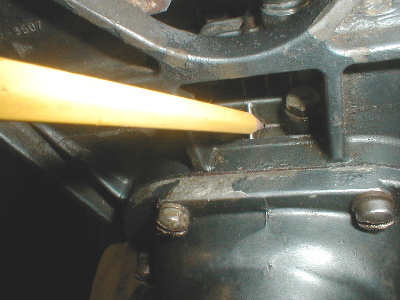
|
Scott Atwater & Firestone
We often forget that in the early 1950's Scott Atwater ran neck-in-neck with Mercury for second place among outboard manufacturers. Scott really tried to "think outside the box" and offer consumers more for their dollar. Full gearshift, a broad selection of horsepower, remote fuel tanks, Bail-a-Matic, interesting styling and other "unique" features were all introduced to help fight the competition. Unfortunately while some of these features were cool, they created real serviceability and longevity problems. One friend of mine in the outboard club commented: "By 1952 Scott must have retired the one good old-time engineer and hired a bunch of grad-students for their engineering department - lots of good ideas but not much common sense". They also had some serious quality control problems with parts and assembly. But let's not get ahead of ourselves, the late forties and early fifties Scott Atwater, Firestone, Corsair and Hiawatha outboards (the last three are Scott private label outboards) are pretty decent motors and reasonably well engineered. The second outboard I ever owned was a 1950 Scott 5hp purchased at a yard sale in 1974 for $15 (talked down from $40 ‘cause the buyer knew it was best to wait and haggle Sunday at 4:30PM!). According to the seller it would be easy to make it run, just needed a little bit of "elbow grease". Sure the engine ran when last used….. when Jack Kennedy was President. At the time I had never seen or heard of a Scott Atwater (they were pretty rare here on the east coast even when they were new, especially around salt water) and thought the name sounded cool. I worked on it for several days trying to get it to go but never did, it's fate is chronicled elsewhere on this website. The motor seen below is a replacement for my second outboard that I got from a friend of mine in the AOMCI. It needed the usual waterpump impeller, magneto replacement and the fuel tank cleaned and lined with Kreem sealer. Half of the gas tank is cast aluminum and the top is stamped steel. The steel rusts and due to dissimilar metals also corrodes horribly where the steel and aluminum meet.
Another problem with this motor is the fuel system. The fuel valve is actuated by the magneto lever and a pretty complex unit that not only turns off the gas but also opens & closes the air vent for the tank. It took some patience and a lot of work to get it to function and not leak. The Tillotson carburetor is equipped with another unique Scott device, a fuel drain. Since the fuel valve is controlled by the magneto, you can't run it out of gas when you want to put it away. The idea is to turn the carburetor control knob to zero and push it in, this actuates the drain. It opens a valve in the float bowl that drains out the bottom of the carb, through a tube and overboard. A friend of mine in the outboard club refers to this feature as "the Devil's own device" since it perpetually leaks! (Ruining your fuel economy and not making you any friends with the EPA.) Once the issues noted above were solved, this motor has become something of a favorite. I really enjoy the elegant styling and it is reasonably quiet and smooth. In addition to being in good shape cosmetically, I was able to acquire an original stand and manual for this motor. Now I really wish I had been able to get the one I had as a kid to run.
For one year, 1953, Scott produced the Gold Pennant 7.5 and 10hp motors. The 1951 and '52 Scott 7.5's and 10's had integral fuel tanks giving them a frumpy, out of proportion look. The Gold Pennant motors were intended to be "sleek" and used remote fuel tanks and a real fuel pump - this was when most of the competition was using pressure tanks. The styling of the Gold Pennant motors is admittedly controversial, but, (other than the previously mentioned Devil's instrument carb drain), they are fairly decent motors. The example seen below was not an outboard I went looking for but came to me as part of a package deal. It languished in my shop for many months but, after moving it for the 100th time, I decided to take a look at it. It required the usual fixes, carburetor, magneto, etc... but turned out to be in pretty good shape, runs well and is very fast!
In 1954 Scott again restyled their motors and introduced their Bail-a-Matic feature. This item was a weighted end and hose that connected to the motor and sucked the bilge water out of the boat using an extra waterpump in the engine. While this is theoretically an interesting and useful idea, (especially in the leaky wooden boats of the day), the Scott engineers executed it extremely poorly by placing both the cooling and bailing pumps together directly under the powerhead - well above the waterline. Here is a scan from the parts manual showing the typical arrangement of the Bail-a-Matic in the leg. (You can click on it for a larger view)
Placing the pumps above the water level means they run without water for several seconds on start-up. During this time the impellers wear very rapidly. Serviceability of the pumps/impellers is a real pain in the butt since the powerhead must be removed along with a complex shift linkage on top of the pump. Complicating everything is the poor choice of materials all the components are made from, (most is steel or other ferris metals).
I do not care for these motors at all, but my son Harry is a big fan of the later Scott Atwater & McCulloch motors (much to my despair). If you are interested in these outboards you can see them on his page at the following link: Harry's Pie Rat Motors Outboard Motors. The sale of Scott-Atwater to McCulloch in 1957 infused a lot of capital and fueled ideas and production for a few years. Mr. Atwater was pleased to get McCulloch's cash but not with keeping his name on the product since it was dropped shortly after the sale. In the early 1960's McCulloch blundered by entirely dropping the Scott name and squandered years of consumer recognition and even some loyalty. In the 60's a fairly large number of badge engineered McCulloch motors sold by Sears, Western Auto and other department stores. Despite the private brand business, by 1964 it was clear that McCulloch's heart was not in the outboard business and each passing year brought a reduction in models and no engineering advancements. I think the lack of a solid dealer/repair network and inherent serviceability problems with the product contributed to McCulloch's failure - by the early 1970's their outboards were gone. Firestone Firestone Tire & Auto stores used to sell more than just tires and tune-ups, in rural areas they were like mini department stores. (With products like the Firestone 500 and the Exploder tires, they probably should have continued!) Many of the items they sold were manufactured by major companies with the Firestone name on them, quality and value were the main selling points of the items offered. The story of Firestone Tire & Rubber and the Scott-Atwater company are closely linked. Originally Scott Atwater was best known as a small outfit that produced novelty items (Like Cracker Jack prizes!). During the depths of the Great Depression they were asked to build a simple, inexpensive outboard motor to be sold through Firestone Tire stores. These Champion outboards sold well and made a good name for themselves. After WWII Champion struck out on their own and Scott Atwater continued to produce outboards for Firestone (now under the Firestone name) and they also started to manufacture outboards under the Scott Atwater name! In later years Firestone split with Scott and used outboards produced by West Bend and finally Clinton or Eska. The Scott and West Bend motors represented a very good value since they were essentially less expensive than the similar name brand motors. From 1946 to 1959 the Firestone outboards shared a lot with their big brother Scott. The major difference was Firestone's use of sheet metal and steal stampings to replace expensive cast aluminum parts (tank, transom clamps, etc..). The use of less expensive components no doubt helped keep the price down and allowed Firestone some profit. Problematic do-hickeys like the automatic fuel/air valve and carburetor drain are thankfully absent on the early 50's private label Scott brands. This makes them a lot more reliable and easier to repair than the Scott Atwater motors of the same size. One nifty feature Firestone offered on some of its mid/late fifties motors was a speedometer (called Knot-o-meter) mounted on the front of the motor and actuated by water pressure. (see 1958 model below)
In 1954 Firestone modernized all but their little single cylinder motor to use remote fuel tanks. Styling was right from the previous years Scott Gold Pennant models (see above) but the same conventional leg and sheet metal transom bracket was retained. Twist grip throttle was another "advanced" feature added to these models.
Someone asked if the '58 Firestone had a water tell-tail to see if it was pumping. I've had this motor for several years and replied that it did not - however I took a very close look and found that indeed it does - however the outlet had been sealed with paint. (from the factory!) Here is a photo of its location in case yours has the same problem!
Today both Scotts and Firestones are often overlooked by outboard enthusiasts. Troubles with the gearshift, water pump and magneto are often difficult to repair and parts are always expensive. Corrosion of fasteners and poor quality construction materials can make these motors frustrating to repair. Be prepared to be patient when working on one, use plenty of PB Blaster, heat and every other trick when wrenching on them. The reward for hours of work and the expense on a Scott/Firestone/Corsair, etc... is a motor that runs well, offered innovative features and is not commonly seen today. Atco Boatimpeller | Bendix | British Seagull | Caille | Champion | Chris Craft | Dragon Fly | Elgin | Elto | Evinrude | Flambeau | Johnson | Lauson | Lockwood Ash | Mac10 Wankel | Martin | Mercury | Misc.Motors | Oliver | Outboard Jet 200 | Pluvier | Scott-Atwater | Tohatsu | Tomos | Volvo | West Bend | Whirlwind(Soviet) | Wizard| Yamaha | Zundapp |
||||||||||||||||||||||||||||||||||||||||||||
